Kirklands Walk Heritage Trail
This is one of the walks within the first batch of Heritage Walks created by Baildon History Society and commissioned by Baildon Parish Council.
The Kirklands Walk
(Distance: about 2 miles or 3.3 km.)
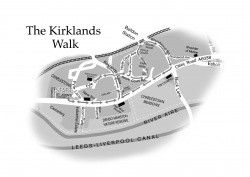
This walk starts and finishes at St John’s Court on Otley Road, and covers points of interest in Charlestown along the Otley Road and the Kirklands area, including St James’s Church.
From St John’s Court to the Half Way House
St John’s Court is a small modern shopping area built in the late 1970s on the site of demolished older terrace housing including a street named St John Street. A separate leaflet gives more information about this central area of Charlestown.
From St John’s Court turn left along Otley Road, towards Otley. You will pass on the left the bottom of Ada Street, a row of nineteenth century housing which escaped the 1970s redevelopment, and further along is Fyfe Lane with a huge sycamore on the corner which gives its name to Sycamore Court.
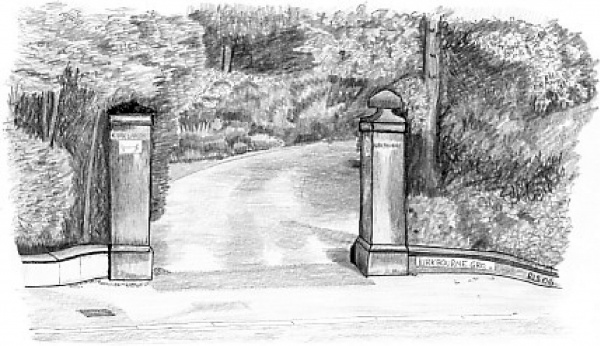
Cross Fyfe Lane and continue along Otley Road to a pair of old stone gate posts with the names Kirklands and Kirkbourne respectively. To the left of these on the main road are a pair of stone houses. These were lodges which were part of the Kirklands estate. According to the 1912 Kelly's Office Directory one housed the coachman and one a gardener. The gateposts stand at the entrance to what is now a private drive called Kirkbourne Drive.
This used to be the long tree lined drive up to the house called Kirklands House. The gardens were large and a 1906 plan shows they contained a vinery, a fernery and stables; and in the grounds at the rear was a coach house. Most of the land was sold off and the drive now leads to some modern houses and Kirkbourne. Kirklands House itself was split up and is now approached from Kirklands Lane, and the coach house was converted into several houses which are approached from Fyfe Grove – both of which we shall see later.

On the opposite side of the main road, where Fern Cottage and the kennels now are, from the latter half of the nineteenth century there used to be the ropeworks of George Copley, rope and twine maker. In 1914 the ropewalk was powered by a 6hp gas engine.
Just past the gateposts of Kirkbourne drive you reach the New Inn pub. This appears on the 1860 OS map but not the 1850 map or 1853 White’s Directory. This is where Cecil Woodward was born (see later). His mother’s family were Yates and it is said they had the New Inn for up to a hundred years. Joseph Yates, a widower, was innkeeper there in 1881 with his 3 sons, 3 daughters and grand-daughter. In the 1970s customers were served by a waiter. Prosperity since then has dipped for such establishments: this pub has recently re-opened after a short period of closure, whilst further back along Otley road at Woodbottom the Queens pub has closed down and is boarded up. This is in keeping with a current trend.
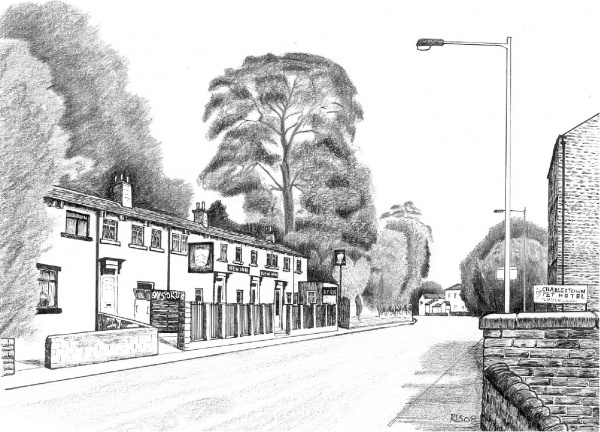
Opposite the New Inn is a road called Briar Rhydding. The old word rhydding indicates that it was cleared (ridden) at some time in the past, presumably of prickly bushes such as wild roses. There used to be an orchard opposite the old stone houses down there, and in one of the houses Cecil Woodward lived in the 1940s and 50s when he searched and discovered many Mesolithic (middle stone age) microliths i.e., tiny flint arrow heads in Charlestown Meadows, the fields between the River Aire and further along Otley Road behind the Half Way House and towards Buck Lane. By the terrace of stone houses is a small block of privies and perhaps a wash house. At the bottom of Briar Rhydding is Baildon Timber, a family business owned by the Baildon family who are descended from the de Bayldon’s of Baildon Hall.
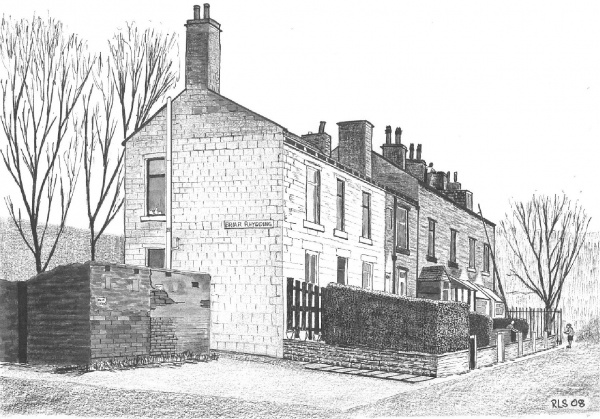
Further along on the right hand side of Otley Road is DENSO Ltd. This is a group of firms with a Japanese parent. The first site before expansion on Otley road was purchased in 1974 for Marston Radiators Ltd, which developed from a small tinsmith’s business making and repairing car radiators behind Leeds Town Hall in 1904 when cars were few, handmade and very expensive. It was taken over by Excelsior Radiator Company and made radiators for a range of cars including the Airedale before becoming part of ICI then IMI and later DENSO. It now makes engine cooling systems for vehicles including major car manufacturers across the world as well as for electric power generation. One of the benefits DENSO has conferred on the area is the creation of a nature reserve down by the river in 1991: the Riverside Walk leaflet takes you through it.
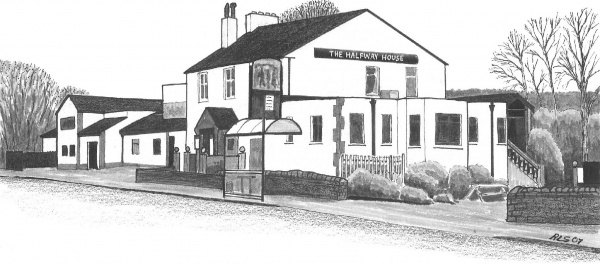
Further along Otley Road, opposite Kirklands Lane, you will see the Half Way House pub, which was previously called the Fleece – indeed, on the 1841 OS map it was the Golden Fleece! On the 1950 OS map it is the Fleece and on the 1960 OS map the Half Way House, so called because it is almost half way between Otley and Bradford as indicated by the old milestone at the bottom of Hollins Hill: Otley 5 miles, Bradford 5 miles. This road, built about 1825, was a Turnpike Trust Road, built for the Kirkstall, Otley and Shipley Trust who charged users a toll. It was the law that there had to be milestones on such roads every mile, and two remain on this stretch of road. Inns along the route provided lodgings and stabling for the horses. In 1921 the Fleece Inn altered its stable into a garage. The Half Way House has been greatly enlarged in recent years particularly the restaurant, part of which was once a games room with dart board. A little past the pub on the right hand side there is a public footpath leading to the riverside footpath and the Denso Marston Nature Reserve.
St James’s Church: The white wooden church
Opposite the pub on the bottom corner of Kirklands Lane is the white wooden St James Church, which has not always occupied its present site, nor even has it always been in Baildon.
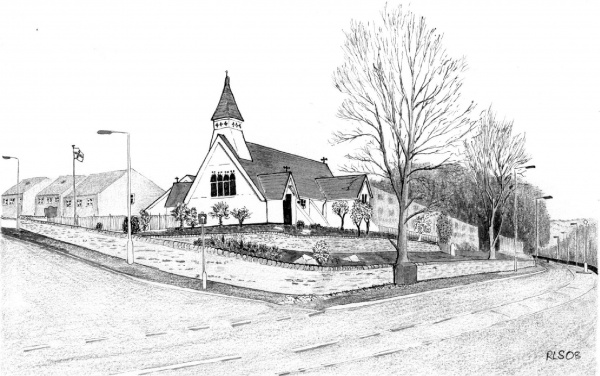
In 1881 a Rev Hammond Roberson Bailey was living at Kirklands with a cook, house maid and parlour maid. He was a very intelligent and well educated Cambridge don who became the rector of Great Warley in Essex in 1866. He was a nephew of William Rand (see below) and became wealthy through inheritance. Before he died in 1900 he arranged for the temporary church in the grounds of his Rectory at Great Warley to be moved to Baildon when repairs to the medieval permanent church there were completed. First consecrated in 1892 and dedicated to St. Mary, it was transported in numbered sections by steam traction engine and opened in 1904 in the middle of a small field which was part of the land owned by the church since medieval times. This was the old white wooden St James’s, which became a striking landmark, being affectionately dubbed ‘the church on the prairie’. It is a Grade II listed building. The church was originally one of two, and the other – which until recently was thought not to have survived – is now thought to be the Church of the Redeemer at Lower Pendock, south of Malvern, in Worcestershire, erected in c1890. St James’s was one of three daughter churches in Baildon Parish. The others were St. Mary’s at Baildon Green and St. Peter’s at Woodbottom, but both have been demolished.
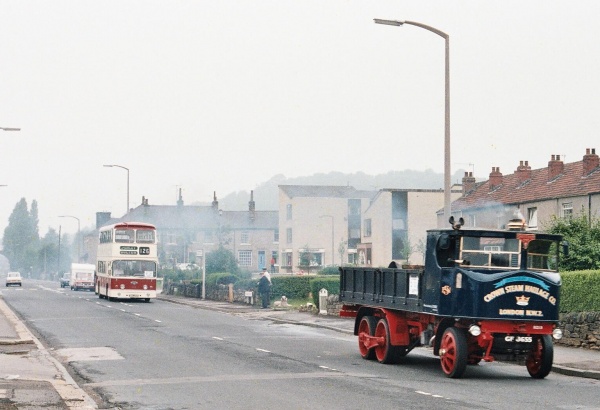
However, maintenance of the church structure proved expensive over the years, and recently it was moved a few yards to its present site at the corner of its field to release the rest of the land for houses – the sale of which financed a major renovation. It closed on Easter Sunday 2007, and the building was modernised with meeting room, modern kitchen and toilet facilities which replaced the old church hall. There is also a ‘biblical garden’ of plants and trees mentioned in the Bible, including olive, fig and vine. It re-opened on 27 April 2008, and is now used for community purposes as well as church services.
This sale of land follows a long tradition of church support in Baildon. As long ago as the twelfth century land known as Kirklands was given to support a chapel of ease in Baildon on Hall Cliffe by a Dame Alice Quintain. Baildon was in Otley Parish until 1869 and the chapel saved people the long trek across the moor for funerals or in bad weather. For those who lived in Low Baildon and the Charlestown area the route would be along old lanes and through hamlets such as Esholt in the valley. The old chapel was replaced in 1848 by the new St John’s parish church (the tower was added after the First World War in memory of those killed) and the church lands have been sold over the centuries to raise money for the church, the most recent being the development of St James Close – the houses immediately beside the white wooden church. Nearby streets with names which include Kirklands, such as Kirklands Lane and Close, indicate that the land was once part of the Kirklands owned by the church.
Within living memory (1950s) local residents (including Willie Rowling – see later) remember there being a farm house and barn immediately behind St James’s at its old site which they called Hoyle Court farm. There was grazing land for animals stretching up to the railway. A track led to the farm from Otley Road.
Kirklands House
If you walk up Kirklands Lane you will pass Kirklands Close and Kirkands Villas on the left and Hartlington Court on the right. The old cobbled courtyard and Kirklands Villas are at the rear part of the old Kirklands House which still remains (the house used to be approached from Otley Road by what is now Kirkbourne Drive). Old maps show a row of buildings on the opposite side of the lane to Kirklands House. In the 1841 Census there are 7 houses at Kirklands housing five farming families, including Major Bradley and a farm labourer and a weaver. Major Bradley is still living there in 1871 with his family and farming 22 acres. He was a tenant farmer.
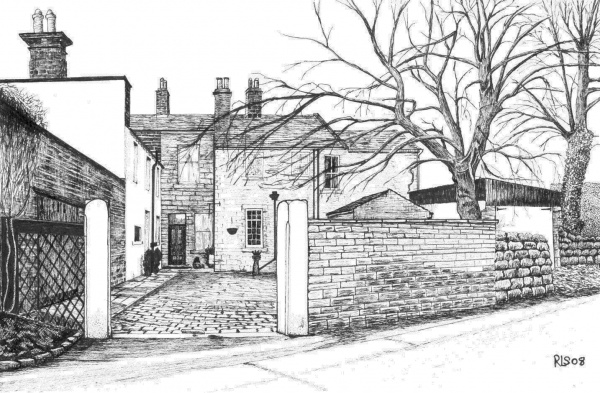
The Mayor of Bradford William Rand had Kirklands House rebuilt and was still living there when he died in 1868. He was a member of the Rand family who owned a mill on the site of the present Victoria statue and war memorial in Bradford. The Rev. Hammond Roberson Bailey inherited Kirklands from his aunt Anne (Nee Anne Rand, his mother's sister). His father's mother, another Ann, was Hammond Roberson's brother. Hammond Roberson is described in Elizabeth Gaskell's ‘Life of Charlotte Bronte’, and features in Charlotte Bronte's Shirley, as Rev. Matthewson. Rev. Hammond R. Bailey's maternal grand-father, John Rand senior, came from the village of Worstead in Norfolk. This was where the worstead branch of the wool textile industry started, before moving to Bradford which became the centre of the industry as Norfolk declined. In 1803 John Rand senior built a factory which was only the third steam driven factory for worsted spinning in Bradford.
In 1891 George Ambler was living at Kirklands House with his two unmarried sisters Sarah and Harriet. They later moved to Woodlands on Roundwood Road. George owned land locally and had a share in the family firm of Jeremiah Ambler and Sons in Bradford. When he died in 1905 he was a very wealthy man. According to the Yorkshire Daily Observer he left about a quarter of a million pounds. In 1951 Percy Monkman, a local artist, was given permission to convert the conservatory of Kirklands House into a studio and garage. In 1961 he was living at 2 Kirklands Villas before moving to Baildon village. Numbers 2 and 4 Kirklands Villas were originally part of the servants quarters of the House. The houses of Hartlington Court were built on the site of Hartlington House which was burnt down in the early 1970s. According to a 1918 indenture the house was previously known as Kirklands Villa.
Kirklands Farm and the old Coach House
Continue up Kirklands Lane and at the crossroads turn left into Fyfe Grove, past the front of Kirklands Farm on the right and some modern (early 1970s) detached houses on the left, until you reach the old Coach House on the left (this used to be the coach house of Kirklands House, approached from Otley Road by what is now Kirkbourne Drive). Behind it in the background you will see the top of Kirkbourne.
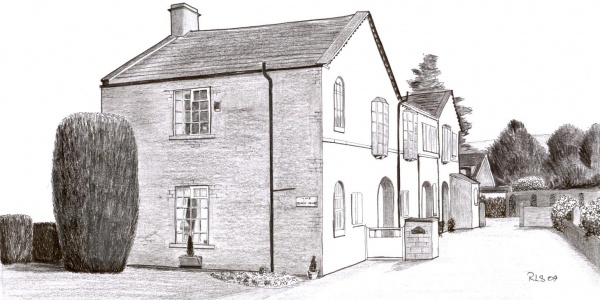
Before returning to the crossroads notice the grounds of Hoyle Court Primary School a little further ahead on the right, officially opened on 23rd March in 1974 by Councillor Keith Vickerman. Children started the previous September 5th. It has been extended and has a nursery.
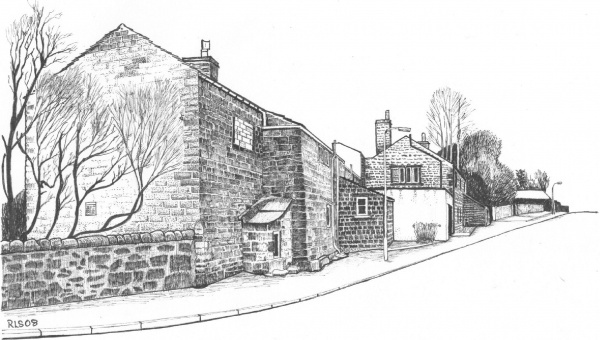
Return to the crossroads, turn left and follow Kirklands Lane round to the left. You will see the back of Kirklands Farm and then Kirklands Cottage on the left. There is the remains of an old beehive oven in the converted farmhouse. According to Sydney Jackson, the late curator of Cartwright Hall Museum, these ceased to be made by about 1700. An indenture dated 1784 concerns Kirklands farm which had been part of the estate of the then deceased William Bolling, father of Francis and Robert Bolling. (This was a branch of the Bolling family of Bolling Hall which had moved to Ilkley.) The farm was worth the yearly sum of £7:10s (£7.50). The indenture records that Francis and Robert Baildon inherited and were entitled to the annual fee farm rent on payment of £178. In 1971 it was a dairy farm rented from Shipley Council and the milk was delivered from a churn by horse and cart before it was bought by its present owner and her late husband at which time it had two barns and two adjacent cottages. They converted it into the large modern house which it is today whilst retaining some original features.
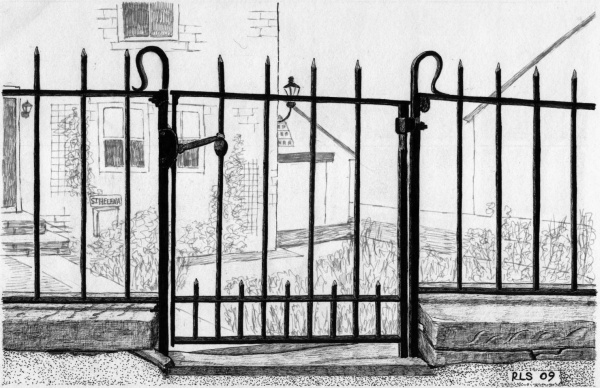
A little further up Kirklands Road on the right is a small row of old cottages called St Helena with an attractive small wrought iron gate which appears to include two shepherd’s crooks. It is thought that this indicates origins connected with wool trade, although in the early C20th the houses were occupied by railway workers.
Hoyle Court
As you retrace your steps back down Kirklands Road to the cross roads yet again, notice the row of villas opposite on the left, some with black and white gables, named Kirklands Avenue. These houses were built by 1901 and are included in the census of that year. They were conveniently placed for Baildon Station which at that time was double track with platform and waiting room at this side of the line. At the cross roads turn left and walk straight along Hoyle Court Road past Hoyle Court Avenue to the junction with Hoyle Court Drive. On the opposite pavement on the corner of Hoyle Court Drive, embedded in the grass of the open-plan blocks of flats, you will see a large rock: it is an example of a cup and ring stone with 3 cups and rings. Dating from the bronze age there is no known reason for this ‘rock art’ although many suggestions have been made, both practical and abstract. There are many other examples in Baildon and elsewhere, but this is the only one locally at such a low elevation – all the others are on the moor. This one was moved 100 metres to here to make for easy viewing when the Hoyle Court estate was being built in the 1970s.
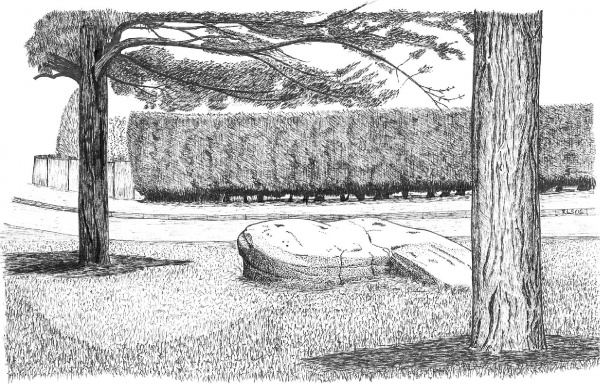
Continue along Hoyle Court Road, following the road round towards Otley Road. Notice immediately after the post box on the left a long drive which leads towards the front of a large house which can partially be seen in amongst the trees. This is Hoyle Court, now a Masonic Lodge, a large house built in 1912 for Sam Ambler, a director and member of the mill owning family. More of this family later.
Turn up left past the post box, keeping Hoyle Court to your right. Walk past the blocks of flats until you reach the road (Hoyle Court Avenue). Here turn right, and at the end of the road left up a short flight of steps to a stone bridge across the railway. However, just before the bridge, turn right down some steps into a footpath: the railway is on your left, a house in a hollow with an old stone roof on your right.
This is Hoyle Court Cottage, built in the eighteenth century when this area was called Hole. There are Parish records of people living ‘in ye Hole’ as long ago as the mid seventeenth century: in 1657 the parish registers record the birth of a child called Mercy at Hole. In 1811 a woolcomber called James Frankland was living there. The Rowling family, headed by Hugh (who farmed 35 acres in 1881) and then his son Samuel Whitehead Rowling, occupied Hole Farm in the nineteenth century, though it was owned by the Ambler family. On the 1893 OS map Hole Farm was here. In the first half of last century there were more buildings. The farm was extended and improved with the addition of a stable and cart shed, and there was more building later – the 1934 Ordnance Survey map shows buildings (now demolished) on the Hoyle Court side of the bridge.
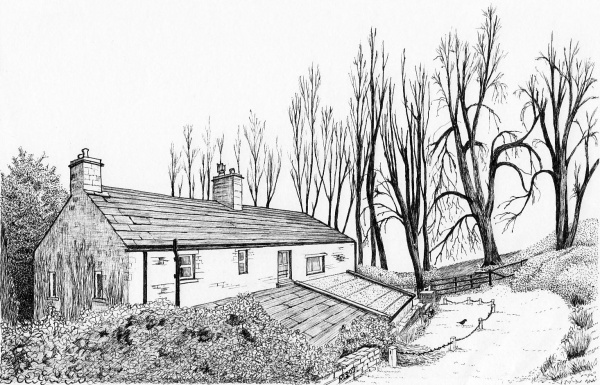
From the middle of the twentieth century the present (2008) owner of Hoyle Court Cottage and her late husband modernised the house installing water and electricity, and kept horses in a paddock and 400 pigs on some of the land nearby, before it was bought by compulsory purchase by Shipley Council for building the Hoyle Court estate of council owned flats in the 1960s and 70s – which you have just walked through. (These flats were in preparation for a large new tax office in Shipley, but after the houses had been built that idea was dropped. When the flats had been let, the tax office was built after all.) Private housing followed soon after.
Roundwood and back to St John’s Court

Continue along the path, which joins a residential drive where you will pass Grey Gables. At one time a drive led from the back to Roundwood Grange, the large Victorian house on the corner where the drive meets Roundwood Road, because this was its lodge and coach house. It had a stable and loft above where the stable boy would sleep. When the present owner (Betty Hart) and her late husband moved in they found some straw upstairs.
Roundwood Grange, on the corner, is almost hidden by trees – the remains of the round wood which gives the house and road their names. This, another Grade II listed building, was built in 1898 for John and Alice Ambler, members of the Jeremiah Ambler and Sons family. The date and their initials are on the building. John and Samuel were sons of Edward Binks Ambler and great grandsons of the Jeremiah who founded the firm in 1783. Combers, spinners and weavers of all kinds of wool and hair, the firm moved to Midland Mills on Valley Road in 1869. The mill buildings are still standing within view of Forster Square station. John (known as John junior) was a director of the company and a JP. His uncle John (John senior) lived at Heaton Mount, Bradford.

Roundwood Grange was built in the Arts and Craft Gothic style with beautiful stained glass and oak panelling. As well as two conventional WC’s, when built it contained a Duckett’s Tippler. This was a type of toilet which could only be found in SE Lancashire and the West Riding of Yorkshire. On the ground floor of the house the sewerage was carried away from the toilet by liquid kitchen waste. One can be seen in the Manchester Museum. From Roundwood Grange John moved to Thorpe Underwood Hall near York. That building is now a private girl’s school. A neighbour of the Amblers of Roundwood Grange was John’s younger brother Samuel Ambler, who had Hoyle Court built in 1912 (see above) and moved there from Heaton. Sam was also a Director of Jeremiah Ambler and Sons Ltd.
Turn right down Roundwood Road. The first road you pass on the left is Park Lane, on which some of the earliest houses were built as part of Tong Park for workers who walked to work at the local mill. The first small inhabited area on Park Lane was known as Park. Further down on the left is Roundwood Avenue which leads behind St James Place. This road used to be called Esholt Lane according to a map of 1841. It was a continuation of the lane from Esholt which passed the Shoulder of Mutton pub on the corner and led up to Baildon village. By the wall, close to the downhill corner of Roundwood Avenue with Round wood Road is an old stone which looks to have the initials ‘WR’ carved on it. They could stand for West Riding, or they could be the initials of someone whose land boundary the stone marked, not necessarily where it is now sited. For instance, the tithe award and map of 1845/6 show that William Rand owned fields near Kirklands. The stone is known to have been in its present location since at least 1926.
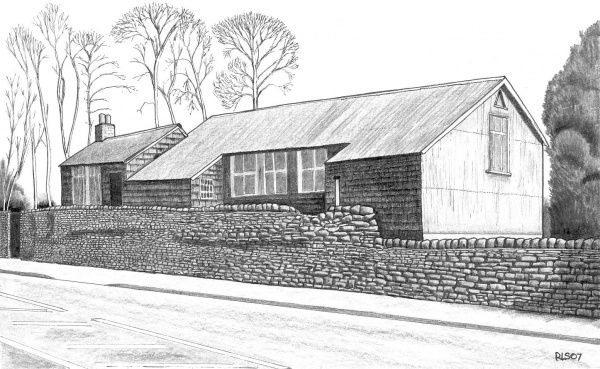
Continue down to the main road. At the junction with Otley Road note Buck Lane opposite. That is an ancient roadway to Idle, which is explored a little more in the Riverside Walk (see separate leaflet). Turn right along Otley Road. Just opposite, in the corner of Buck Lane with Otley Road, is a small industrial complex. The rather overgrown building nearest Otley Road, with the corrugated iron roof and shingle sides, was built as St James Mission Church in 1869 and seated 200. This is also described in more detail in the Riverside Walk leaflet.
Continue along Otley Road until you come to Hoyle Court Road. Before the Hoyle Court estate was built there was a lodge here at the end of a tree lined drive leading up to the rear of Hoyle Court (the Masonic Lodge noted earlier) and stopping at a row of buildings (now demolished) at the side of Hoyle Court Cottage up by the railway line (as shown on the 1934 OS map). Willie Rowling (see above) and his wife and family lived at the lodge in the 1940s. The 1861 census records a farmer called William Ives at Hole Top. The 1845-6 Baildon tithe map shows a small group of buildings and land farmed by William Ives at the end of a track straight on from where there is now the railway footbridge to the other side of the line.
This completes the walk, and your way back to St John’s Court lies along Otley Road (you can catch a bus). For a quieter route you can walk along Hoyle Court Road to the cross roads, then straight across into Fyfe Grove to the next cross roads where you turn left down Fyfe Lane to Otley Road. Turn right towards the zebra crossing at St John’s Court.
If you came by train, make your way back up through the flats towards the railway and across the footbridge you have already seen on this walk. This takes you to the station.
Note about distance
This is a reasonably short walk, but you may well find you walk further than the indicated 2 miles (3.3 km.). Distances were measured from Google maps using their distance measuring tool in straight lines, but you are likely to wander here and there a bit, and add a few detours of your own. So regard the distance given as an approximate minimum.